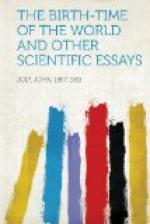thing there is sometimes, along with very large amounts of thorium, an almost entire absence of lead in thorianites and thorites. And in some urano—thorites the lead may be noticed to follow the uranium in approximate proportionality, notwithstanding the presence of large amounts of thorium.[1] This is in favour of the assumption that all the lead present is derived from the uranium. The actinium is present in negligibly small amounts.
On the other hand, there is evidence arising from the atomic weight of lead which seems to involve some other parent than uranium. Soddy, in the work referred to, points this out. The atomic weight of radium is well known, and uranium in its descent has to change to this element. The loss of mass between radium and uranium-derived lead can be accurately estimated by the number of alpha rays given off. From this we get the atomic weight of uranium-derived lead as closely 206. Now the best determinations of the atomic weight of normal lead assign to this element an atomic weight of closely
[1] It seems very difficult at present to suggest an end product for thorium, unless we assume that, by loss of electrons, thorium E, or thorium-lead, reverts to a substance chemically identical with thorium itself. Such a change—whether considered from the point of view of the periodic law or of the radioactive theory would involve many interesting consequences. It is, of course, quite possible that the nature of the conditions attending the deposition of the uranium ores, many of which are comparatively recent, are responsible for the difficulties observed. The thorium and uranium ores are, again, specially prone to alteration.
25
207. By a somewhat similar calculation it is deduced that thorium-derived lead would possess the atomic weight of 208. Thus normal lead might be an admixture of uranium- and thorium-derived lead. However, as we have seen, the view that thorium gives rise to stable lead is beset with some difficulties.
If we are going upon reliable facts and figures, we must, then, assume: (a) That some other element than uranium, and genetically connected with it (probably as parent substance), gives rise, or formerly gave rise, to lead of heavier atomic weight than normal lead. It may be observed respecting this theory that there is some support for the view that a parent substance both to uranium and thorium has existed or possibly exists. The evidence is found in the proportionality frequently observed between the amounts of thorium and uranium in the primary rocks.[1] Or: (b) We may meet the difficulties in a simpler way, which may be stated as follows: If we assume that all stable lead is derived from uranium, and at the same time recognise that lead is not perfectly homogeneous in atomic weight, we must, of necessity, ascribe to uranium a similar want of homogeneity; heavy atoms of uranium giving rise to heavy
[1] Compare results for the thorium content of such rocks (appearing in a paper by the author Cong. Int. de Radiologie et d’Electricite, vol. i., 1910, p. 373), and those for the radium content, as collected in Phil. Mag., October, 1912, p. 697. Also A. L. Fletcher, Phil. Mag., July, 1910; January, 1911, and June, 1911. J. H. J. Poole, Phil. Mag., April, 1915




